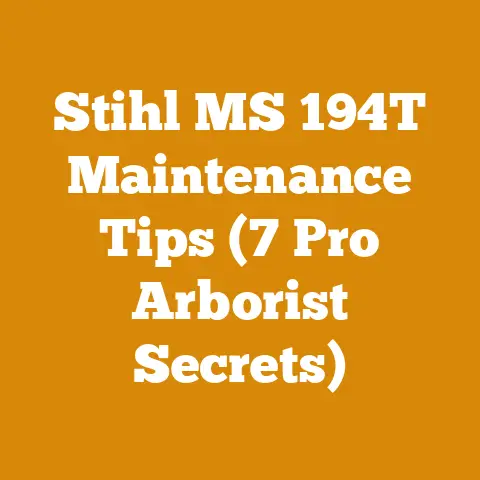Home Built Outdoor Wood Boiler (5 Pro Tips for Efficient Heating)
Remember the biting chill of winter, the way it seeps into your bones no matter how many layers you wear? I do. I grew up in a small mountain town where wood was king – our primary source of heat, our lifeblood against the relentless cold. We relied on a traditional wood stove, and while it worked, it was inefficient, demanding constant attention and producing uneven heat. I yearned for something better, something that could truly conquer the winter. That’s what led me down the path of researching and eventually building my own outdoor wood boiler. It was a journey of trial and error, of countless hours spent tinkering and learning, but the reward – the consistent, comfortable warmth that permeated our home – was worth every drop of sweat. Now, I want to share that knowledge with you, so you too can harness the power of efficient wood heating. This isn’t just about building a boiler; it’s about gaining independence, saving money, and connecting with a time-honored tradition of self-reliance.
Home Built Outdoor Wood Boiler: 5 Pro Tips for Efficient Heating
Building your own outdoor wood boiler might seem like a daunting task, but with the right knowledge and approach, it’s entirely achievable. This guide will provide you with five essential pro tips to ensure your home-built boiler operates safely and efficiently, maximizing heat output while minimizing wood consumption. I’ll draw on my own experiences, research, and understanding of wood processing to guide you through the process.
1. Understanding the Fundamentals: Boiler Design and Heat Transfer
Before diving into the construction, it’s crucial to grasp the fundamental principles behind outdoor wood boiler operation. This knowledge will inform your design choices and ensure a safe and efficient system.
-
What is an Outdoor Wood Boiler? An outdoor wood boiler, also known as an outdoor wood furnace, is essentially a large firebox surrounded by a water jacket. The fire heats the water, which is then circulated to your home through insulated underground pipes. This hot water can be used for space heating (radiators, radiant floor heating) and domestic hot water.
-
Key Components:
- Firebox: The combustion chamber where the wood is burned. Size and design are critical for efficient combustion.
- Water Jacket: Surrounds the firebox and absorbs heat, transferring it to the water. Proper insulation is crucial to minimize heat loss.
- Heat Exchanger: Transfers heat from the hot water to your home’s heating system (e.g., a water-to-air heat exchanger for forced-air systems or a plate heat exchanger for hydronic systems).
- Pump: Circulates the hot water between the boiler and your home.
- Chimney: Vents the exhaust gases from the firebox.
- Controls: Thermostat, aquastat, and other sensors to regulate temperature and pump operation.
-
Heat Transfer Principles: Efficient boiler design hinges on maximizing heat transfer from the fire to the water. This involves understanding:
- Conduction: Heat transfer through direct contact. Thicker metal in the firebox and water jacket facilitates better conduction.
- Convection: Heat transfer through the movement of fluids (air and water). Proper airflow within the firebox and water circulation around the firebox are essential.
- Radiation: Heat transfer through electromagnetic waves. The fire radiates heat onto the water jacket.
-
My Experience: In my first attempt, I underestimated the importance of the water jacket’s design. I used thinner gauge steel, and the heat transfer was significantly lower than expected. The water never reached optimal temperatures, and I ended up burning more wood. This experience taught me the value of proper material selection and design considerations.
-
Key Terms:
- BTU (British Thermal Unit): A measure of heat energy. Boilers are rated by their BTU output.
- Aquastat: A temperature-sensitive switch that controls the pump, ensuring water is circulated only when it reaches a certain temperature.
- Hydronic Heating: A heating system that uses water as the heat transfer medium.
-
Design Considerations:
- Boiler Size: This depends on the size of your home and your heating needs. A BTU calculation is essential. Online calculators and professional consultations can help.
- Firebox Size: A larger firebox allows for longer burn times but may also require more wood.
- Water Jacket Volume: A larger volume provides greater thermal mass, reducing temperature fluctuations.
- Insulation: Proper insulation is critical to minimize heat loss. High-temperature fiberglass or spray foam are common choices.
2. Material Selection: Choosing the Right Steel and Components
The longevity and efficiency of your outdoor wood boiler depend heavily on the materials you choose. Don’t cut corners here – investing in quality materials will save you money and headaches in the long run.
-
Steel Selection:
- Firebox: Use thick-gauge steel (at least 1/4 inch) for the firebox. A36 steel is a common and affordable option. Consider using boiler plate steel (ASTM A516 Grade 70) for superior heat resistance and durability, especially if you plan on operating the boiler at high temperatures.
- Water Jacket: 3/16 inch or 1/4 inch steel is suitable for the water jacket. Ensure the steel is compatible with welding.
- Why Thickness Matters: Thicker steel absorbs and retains heat better, reducing heat loss and increasing efficiency. It also withstands the high temperatures and pressure inside the boiler for longer.
-
Welding: Proper welding is crucial for a leak-proof and structurally sound boiler. Use a qualified welder with experience in working with thick-gauge steel. Pay close attention to weld penetration and quality.
-
Piping and Fittings:
- Underground Piping: Use pre-insulated PEX or PEX-AL-PEX piping specifically designed for underground burial. This will minimize heat loss and prevent corrosion.
- Fittings: Use high-quality brass or stainless steel fittings to avoid leaks and corrosion.
-
Pumps: Choose a circulator pump designed for hot water heating systems. Consider a variable-speed pump for increased efficiency and quieter operation. Taco and Grundfos are reputable brands.
-
Controls:
- Thermostat: A programmable thermostat allows you to set different temperatures for different times of the day, saving energy.
- Aquastat: An essential safety device that prevents the pump from running when the water is too cold, protecting the system from freezing.
- Safety Relief Valve: A critical safety component that releases pressure if the boiler overheats.
-
Insulation:
- High-Temperature Fiberglass: A cost-effective option for insulating the boiler. Wrap the boiler in multiple layers of fiberglass insulation and secure it with metal strapping.
- Spray Foam: Provides excellent insulation and seals air gaps. Ensure the spray foam is rated for high temperatures.
-
My Experience: I initially used standard plumbing fittings for my underground piping. Within a year, they started to corrode, leading to leaks and significant heat loss. I learned the hard way that investing in proper pre-insulated PEX piping and high-quality fittings is essential for long-term reliability.
-
Cost Considerations: While high-quality materials may have a higher upfront cost, they will save you money in the long run by reducing heat loss, preventing leaks, and extending the lifespan of your boiler.
-
Tool Specification:
- Welding Machine: MIG or Stick welder capable of welding thick-gauge steel.
- Cutting Torch: Plasma cutter or oxy-acetylene torch for cutting steel.
- Grinder: Angle grinder with various grinding and cutting wheels.
- Measuring Tools: Tape measure, level, square.
3. Combustion Efficiency: Optimizing the Firebox and Airflow
Efficient combustion is the key to maximizing heat output and minimizing wood consumption. This involves optimizing the firebox design and ensuring proper airflow.
-
Firebox Design:
- Size: The firebox should be large enough to hold a sufficient amount of wood for extended burn times but not so large that it reduces combustion efficiency.
- Shape: A cylindrical or rectangular firebox with rounded corners is generally more efficient than a square firebox.
- Secondary Combustion: Consider incorporating a secondary combustion chamber to burn off gases and smoke, increasing efficiency and reducing emissions. This can be achieved with a refractory-lined chamber and strategically placed air inlets.
-
Airflow:
- Primary Air: Air that enters the firebox at the bottom, fueling the initial combustion.
- Secondary Air: Air that enters the firebox higher up, burning off gases and smoke.
- Air Control: Implement adjustable air inlets to control the amount of primary and secondary air, allowing you to fine-tune the combustion process.
-
Wood Preparation:
- Seasoned Wood: Burning seasoned wood (wood that has been dried for at least six months) is crucial for efficient combustion. Seasoned wood contains less moisture, allowing it to burn hotter and more completely.
- Wood Size: Split wood into pieces that are appropriately sized for your firebox. Smaller pieces burn faster, while larger pieces burn slower.
-
Combustion Techniques:
- Top-Down Burning: Loading the firebox with larger pieces of wood at the bottom and smaller pieces on top can promote more complete combustion.
- Airflow Adjustment: Experiment with different airflow settings to find the optimal balance for your wood type and firebox design.
-
My Experience: I struggled with excessive smoke and creosote buildup in my chimney during the initial stages. I realized that I wasn’t providing enough secondary air to burn off the gases. By adding adjustable air inlets and experimenting with different airflow settings, I was able to significantly reduce smoke and increase combustion efficiency.
-
Key Concepts:
- Creosote: A flammable substance that accumulates in chimneys and can cause chimney fires.
- Complete Combustion: Burning wood completely, leaving behind only ash.
- BTU/lb: BTU per pound, a measure of the energy content of wood.
-
Wood Type Selection: Hardwoods like oak, maple, and ash have a higher BTU content than softwoods like pine and fir. This means they produce more heat per pound of wood. However, softwoods ignite more easily and can be useful for starting fires. A mix of hardwoods and softwoods is often ideal.
-
Data and Statistics:
- Seasoned hardwood can have a BTU content of 8,000-9,000 BTU/lb.
- Green wood can have a moisture content of 50% or higher, significantly reducing its BTU content.
- Proper combustion can increase boiler efficiency by 20-30%.
4. Water Circulation and Heat Exchangers: Getting the Heat Where It Needs to Go
Efficient heat transfer from the boiler to your home relies on proper water circulation and a well-matched heat exchanger.
-
Water Circulation:
- Pump Sizing: The pump must be sized correctly to circulate the water through the system at the required flow rate. Consult with a heating professional or use online calculators to determine the appropriate pump size.
- Piping Layout: Design the piping layout to minimize pressure drop and ensure even heat distribution. Use larger diameter pipes for longer runs.
- Expansion Tank: An expansion tank is essential to accommodate the expansion of water as it heats up.
-
Heat Exchangers:
- Water-to-Air Heat Exchanger: Used for forced-air heating systems. The hot water circulates through the heat exchanger, transferring heat to the air, which is then distributed through the ductwork.
- Plate Heat Exchanger: A more efficient option for hydronic heating systems. It transfers heat from the boiler water to a separate loop of water that circulates through your home’s radiators or radiant floor heating system.
- Sizing: The heat exchanger must be sized correctly to transfer the required amount of heat. Consult with a heating professional to determine the appropriate size.
-
System Integration:
- Mixing Valve: A mixing valve can be used to blend hot water from the boiler with cooler water from your home’s heating system, maintaining a consistent temperature.
- Zone Valves: Zone valves allow you to control the heat in different areas of your home independently.
-
My Experience: In my initial setup, I used an undersized pump, and the heat distribution was uneven. Some rooms were too hot, while others were too cold. Upgrading to a larger pump and optimizing the piping layout resolved the issue.
-
Strategic Advantages:
- Efficient Heat Distribution: Proper water circulation ensures that heat is distributed evenly throughout your home.
- Precise Temperature Control: A well-matched heat exchanger and mixing valve allow for precise temperature control.
- Reduced Energy Consumption: Efficient heat transfer minimizes energy loss and reduces wood consumption.
-
Case Study: A homeowner in Vermont installed a home-built outdoor wood boiler with a plate heat exchanger to heat their 2,000 square foot home. By optimizing the water circulation and using a properly sized heat exchanger, they were able to reduce their heating costs by 70% compared to their previous propane heating system.
-
Technical Details:
- Pump flow rate is typically measured in gallons per minute (GPM).
- Heat exchanger capacity is typically measured in BTU/hr.
- Piping diameter is typically measured in inches.
5. Safety and Maintenance: Protecting Your Investment and Your Family
Safety is paramount when operating an outdoor wood boiler. Regular maintenance is also essential to ensure optimal performance and longevity.
-
Safety Precautions:
- Clearance: Maintain a safe clearance around the boiler to prevent fire hazards. Consult with your local fire department for specific requirements.
- Chimney Inspection: Inspect the chimney regularly for creosote buildup and clean it as needed.
- Carbon Monoxide Detector: Install a carbon monoxide detector in your home to alert you to any potential leaks.
- Safety Relief Valve: Ensure the safety relief valve is functioning properly and is not blocked.
- Water Level: Maintain the proper water level in the boiler.
-
Maintenance:
- Ash Removal: Remove ash from the firebox regularly to maintain efficient combustion.
- Water Treatment: Treat the water in the boiler with a corrosion inhibitor to prevent rust and scale buildup.
- Insulation Inspection: Inspect the insulation regularly for damage and repair it as needed.
- Pump Maintenance: Lubricate the pump motor as needed and replace the pump if it becomes worn out.
- Professional Inspection: Have the boiler professionally inspected annually to ensure it is operating safely and efficiently.
-
Firewood Stacking: Proper firewood stacking promotes air circulation and speeds up the drying process. Stack wood in a single row, off the ground, and in a sunny location. Cover the top of the stack to protect it from rain and snow.
-
My Experience: I neglected to clean my chimney regularly, and I ended up with a chimney fire. Fortunately, I was able to extinguish it quickly, but it was a terrifying experience. This taught me the importance of regular chimney maintenance.
-
Legal Considerations: Check with your local authorities for any permits or regulations regarding outdoor wood boilers. Some areas may have restrictions on emissions or setbacks from property lines.
-
Tools for Maintenance:
- Chimney Brush: For cleaning the chimney.
- Ash Shovel: For removing ash from the firebox.
- Water Treatment Kit: For testing and treating the water in the boiler.
- Insulation Repair Kit: For repairing damaged insulation.
-
Cost Estimates:
- Annual chimney cleaning: $100-$200
- Water treatment: $50-$100 per year
- Professional inspection: $200-$300 per year
-
Skill Levels Required: Building and maintaining an outdoor wood boiler requires a range of skills, including welding, plumbing, electrical wiring, and carpentry. If you are not comfortable with these skills, consider hiring a professional.
Building your own outdoor wood boiler is a challenging but rewarding project. By following these five pro tips, you can ensure that your boiler operates safely and efficiently, providing you with years of reliable heat. Remember to prioritize safety, use high-quality materials, and perform regular maintenance.
Next Steps:
- Research: Thoroughly research local regulations and building codes.
- Design: Create a detailed design plan, including boiler size, firebox dimensions, and water jacket volume.
- Materials: Source high-quality materials from reputable suppliers.
- Construction: Carefully follow your design plan and prioritize safety.
- Testing: Thoroughly test the boiler before connecting it to your home’s heating system.
- Maintenance: Establish a regular maintenance schedule to ensure optimal performance and longevity.
With dedication and careful planning, you can successfully build your own outdoor wood boiler and enjoy the warmth and independence it provides. Embrace the challenge, learn from your mistakes, and take pride in your accomplishment. The satisfaction of heating your home with wood you’ve harvested and processed yourself is truly unparalleled. Good luck!






